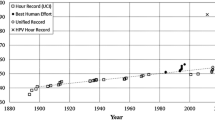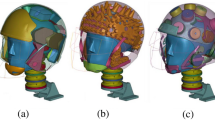Abstract
The dynamic behaviour of racetrack surfaces during hoof impact is a likely risk factor for racehorse injuries and fatalities. A track-testing device that simulates equine hoof impact was used to assess the effects of surface type (dirt, synthetic), surface depth (2, 3, 4 layers), test boundary area (929, 6,606, 11,381 cm2), harrowing, and impact angle (0°, 20° from vertical) on dynamic surface properties. Surfaces were tested within a laboratory track-in-a-box. Surface type and depth, boundary area, and harrowing significantly affected dynamic surface properties during impacts (P < 0.05). The synthetic surface was generally less stiff, and had 26–73% lower maximum impact forces and load rates, than the dirt surface. Harrowing decreased stiffness and differences between dirt and synthetic properties. Measured surface stiffness was larger for the smallest depth and boundary area, but most surface properties were not significantly different between the larger boundary areas. Surfaces were less stiff with angled impacts than vertical impacts.








Similar content being viewed by others
References
Stover SM (2003) The epidemiology of Thoroughbred racehorse injuries. Clin Tech Equine Pract 2(4):312–322
Arthur RM (2010) Comparison of racing fatality rates on dirt, synthetic and turf at four California race tracks. In: 56th Annu Meet Am Assoc Equine Pract, Proceedings, Baltimore, pp 405–408
Thomason JJ, Peterson ML (2008) Biomechanical and mechanical investigations of the hoof-track interface in racing horses. Vet Clin North Am Equine Pract 24(1):53–77
Setterbo JJ, Garcia TC, Campbell IP, Reese JL, Morgan JM, Kim SY, Hubbard M, Stover SM (2009) Hoof accelerations and ground reaction forces of Thoroughbred racehorses measured on dirt, synthetic, and turf track surfaces. Am J Vet Res 70(10):1220–1229
Robin D, Chateau H, Pacquet L, Falala S, Valette JP, Pourcelot P, Ravary B, Denoix JM, Crevier-Denoix N (2009) Use of a 3D dynamometric horseshoe to assess the effects of an all-weather waxed track and a crushed sand track at high speed trot: preliminary study. Equine Vet J 41(3):253–256
Crevier-Denoix N, Pourcelot P, Ravary B, Robin D, Falala S, Uzel S, Grison AC, Valette JP, Denoix JM, Chateau H (2009) Influence of track surface on the equine superficial digital flexor tendon loading in two horses at high speed trot. Equine Vet J 41(3):257–261
Chateau H, Robin D, Falala S, Pourcelot P, Valette JP, Ravary B, Denoix JM, Crevier-Denoix N (2009) Effects of a synthetic all-weather waxed track versus a crushed sand track on 3D acceleration of the front hoof in three horses trotting at high speed. Equine Vet J 41(3):247–251
Cheney JA, Shen CK, Wheat JD (1973) Relationship of racetrack surface to lameness in the Thoroughbred racehorse. Am J Vet Res 34(10):1285–1289
Peterson ML, Wayne McIlwraith C, Reiser Ii RF (2008) Development of a system for the in situ characterisation of thoroughbred horse racing track surfaces. Biosyst Eng 101(2):260–269
Ratzlaff MH, Hyde ML, Hutton DV, Rathgeber RA, Balch OK (1997) Interrelationships between moisture content of the track, dynamic properties of the track and the locomotor forces exerted by galloping horses. J Equine Vet Sci 17(1):35–42
Peterson ML, McIlwraith CW (2008) Effect of track maintenance on mechanical properties of a dirt racetrack: a preliminary study. Equine Vet J 40(6):602–605
Ratzlaff MH, Wilson PD, Hutton DV, Slinker BK (2005) Relationships between hoof-acceleration patterns of galloping horses and dynamic properties of the track. Am J Vet Res 66(4):589–595
Nigg BM (1990) The validity and relevance of tests used for the assessment of sports surfaces. Med Sci Sports Exerc 22(1):131–139
Roland E, Stover SM, Hull ML, Dorsch K (2003) Geometric symmetry of the solar surface of hooves of Thoroughbred racehorses. Am J Vet Res 64(8):1030–1039
Setterbo JJ (2011) Comparison of equine racetrack dynamic surface properties and development of a surface-testing system. Doctoral Dissertation, University of California, Davis
ASTM D5874-02 (Reapproved 2007) (2007) Standard test method for determination of the impact value (IV) of a Soil. ASTM annual book of standards
ASTM D2216-05 (2005) Standard test methods for laboratory determination of water (moisture) content of soil and rock by mass. ASTM annual book of standards
Johnston C, Hjerten G, Drevemo S (1991) Hoof landing velocities in trotting horses. In: Persson SG, Lindholm A, Jeffcott LB (eds) Equine exercise physiology 3. ICEEP Publications, Davis, pp 167–172
Dixon SJ, Batt ME, Collop AC (1999) Artificial playing surfaces research: a review of medical, engineering and biomechanical aspects. Int J Sports Med 20(04):209, 218
Stiles VH, James IT, Dixon SJ, Guisasola IN (2009) Natural turf surfaces: the case for continued research. Sports Med 39(1):65–84
Neylan J (1997) Review of devices currently available for assessing racetrack conditions. Project Number PTP-5A. Rural Industries Research and Development Corporation, Barton
Witte TH, Knill K, Wilson AM (2004) Determination of peak vertical ground reaction force from duty factor in the horse (Equus caballus). J Exp Biol 207(21):3639–3648
Henwood K (1969) A study of the dynamic response of soils under impulse loading. Masters, University of California
Pratt GW (1985) Racetrack surface biomechanics. Equine Vet Data 6(13):193–202
Das BM (2008) Advanced Soil Mechanics, 3rd edn edn. Taylor & Francis, New York
Gill WR, Vanden Berg GE (1968) Soil dynamics in tillage and traction. U.S. Government Printing Office, Washington, DC
Garciano LO, Upadhyaya SK, Jones RA, Jersey SR (2007) Determination of the soil pressure distribution around a cone penetrometer. J Terramech 44(3):265–273
Acknowledgments
Supported by grants from the Grayson-Jockey Club Research Foundation, the Southern California Equine Foundation, and the Center for Equine Health with funds provided by the State of California pari-mutuel fund and contributions by private donors. The authors thank Dr. Marc Ratzlaff of Washington State University for donating the track-testing device, and Keeneland Race Course and Martin Collins Surfaces & Footings LLC, makers of Polytrack, for donating the laboratory box and materials to build the synthetic surface base.
Author information
Authors and Affiliations
Corresponding author
Rights and permissions
About this article
Cite this article
Setterbo, J.J., Yamaguchi, A., Hubbard, M. et al. Effects of equine racetrack surface type, depth, boundary area, and harrowing on dynamic surface properties measured using a track-testing device in a laboratory setting. Sports Eng 14, 119–137 (2011). https://doi.org/10.1007/s12283-011-0073-4
Published:
Issue Date:
DOI: https://doi.org/10.1007/s12283-011-0073-4




